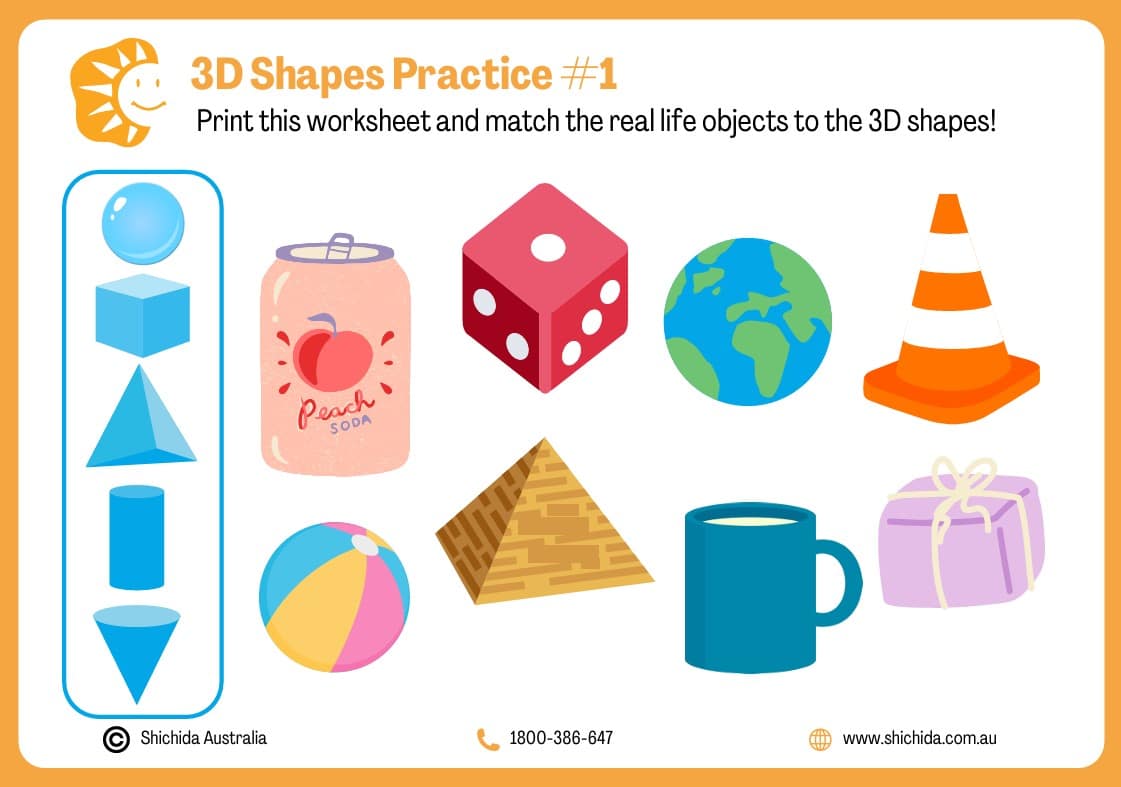Explore 3D Shapes with Our Practice Worksheets
Introduce your child to the engaging world of three-dimensional figures with our 3D Shapes Practice worksheets. Designed for young learners, these activities provide a fun and interactive way to understand and create 3D shapes, linking them to real-world objects and offering hands-on building experiences.
This practical approach helps lay a strong foundation in recognising and constructing 3D shapes, which is essential for their cognitive development.
Benefits of Learning 3D Shapes in Early Childhood
- Enhances Spatial Awareness: Learning about 3D shapes enables children to comprehend how different objects relate to each other in space. This understanding is crucial as it aids in developing their ability to judge distances and understand spatial relationships, skills that are important both in academic settings and everyday life.
- Develops Problem-Solving Skills: Building three-dimensional objects from two-dimensional drawings challenges young minds to think critically and approach problem-solving in a creative manner. These skills are essential for academic success and help children become effective learners.
- Boosts Motor Skills and Precision: Constructing 3D shapes, such as cutting, folding, and glueing, is excellent for refining fine motor skills and enhancing hand-eye coordination. These skills are vital for writing, using tools, and performing other precision-based tasks.
- Fosters Critical Thinking: Working with 3D shapes helps children understand the properties of different geometric figures and how they can be used together. This kind of exploration develops their analytical skills and enhances their ability to reason and apply logic.
Practical Applications and Fun Learning Activities
3D Shapes Practice #1: This worksheet encourages children to match common objects in their environment to their corresponding 3D shapes, enhancing their ability to connect abstract concepts with tangible items. This activity improves cognitive skills and helps children apply their knowledge in everyday situations.
3D Shapes Practice #2: Building a cube from scratch is an excellent introduction to geometric construction. This step-by-step activity promotes an understanding of geometry and gives children a sense of achievement as they create a physical object from a flat diagram.
Continued Learning: Practical Activities for 3D Shapes
After your child works on the ‘3D Shapes Practice’ worksheets, keep the learning going with these fun and practical activities. These ideas will help reinforce the concepts they’ve learned and demonstrate how these shapes apply to the world around them:
Finding shapes: Make it a game to spot and name 3D shapes during your daily routines. Whether it’s a sphere like a soccer ball or a cube like a dice, pointing these out helps children understand that the shapes they learn about aren’t just on paper—they’re everywhere.
Building shapes: Encourage your child to use a variety of materials such as play dough, cardboard, or building blocks to create their own 3D shapes. This hands-on construction is a great way to deepen their understanding of how shapes come together and function in three dimensions.
Shapes in arts and crafts: Integrate 3D shapes into arts and crafts activities by creating sculptures or 3D collages. These activities make learning more enjoyable and help children appreciate how fun and functional shapes are.
Download the ‘3D Shapes Practice’ worksheets now and start a fascinating journey into the world of three-dimensional shapes.
At Shichida Australia, we offer classes that enhance and build on what your child learns at home. Our comprehensive and interactive learning environment supports all aspects of early childhood education. Join us for a trial class!
